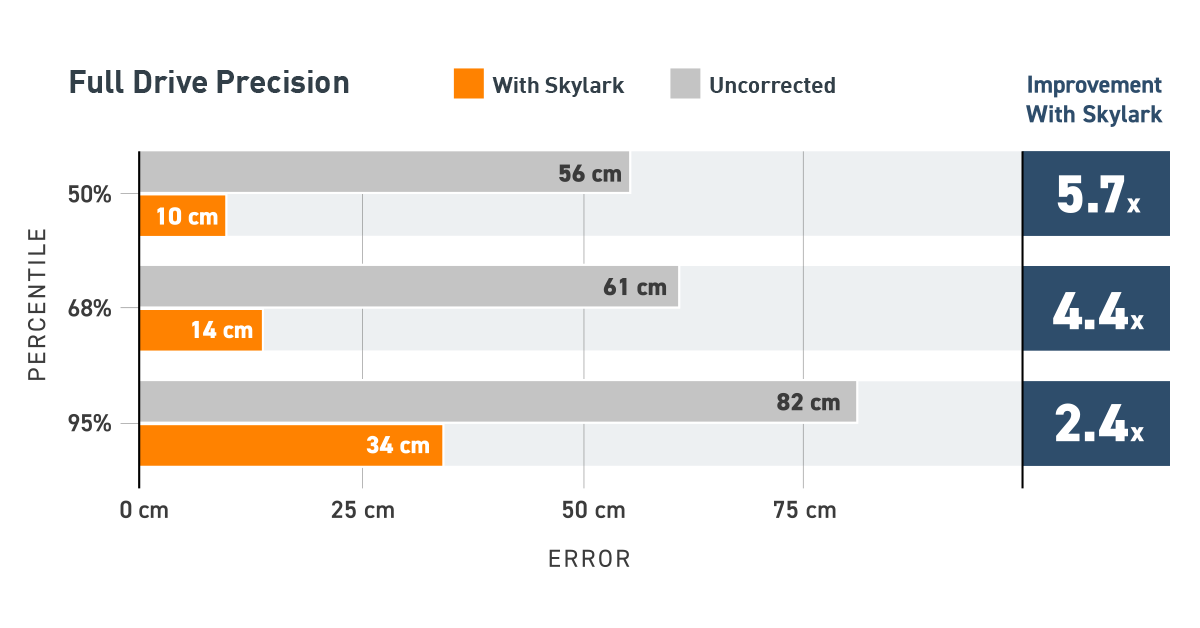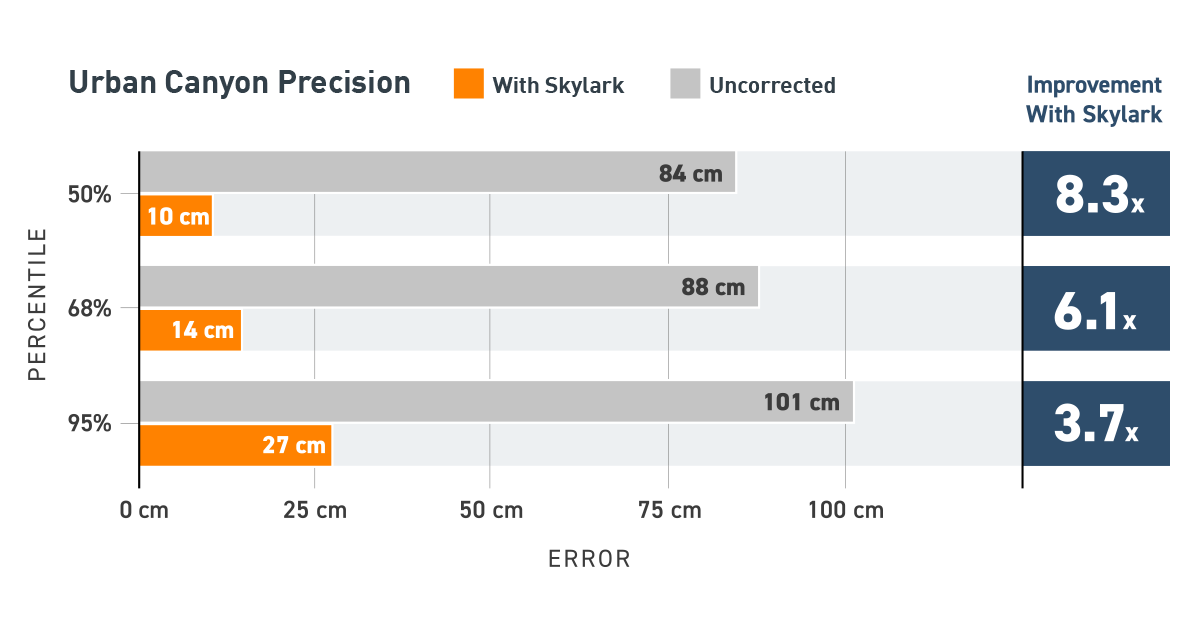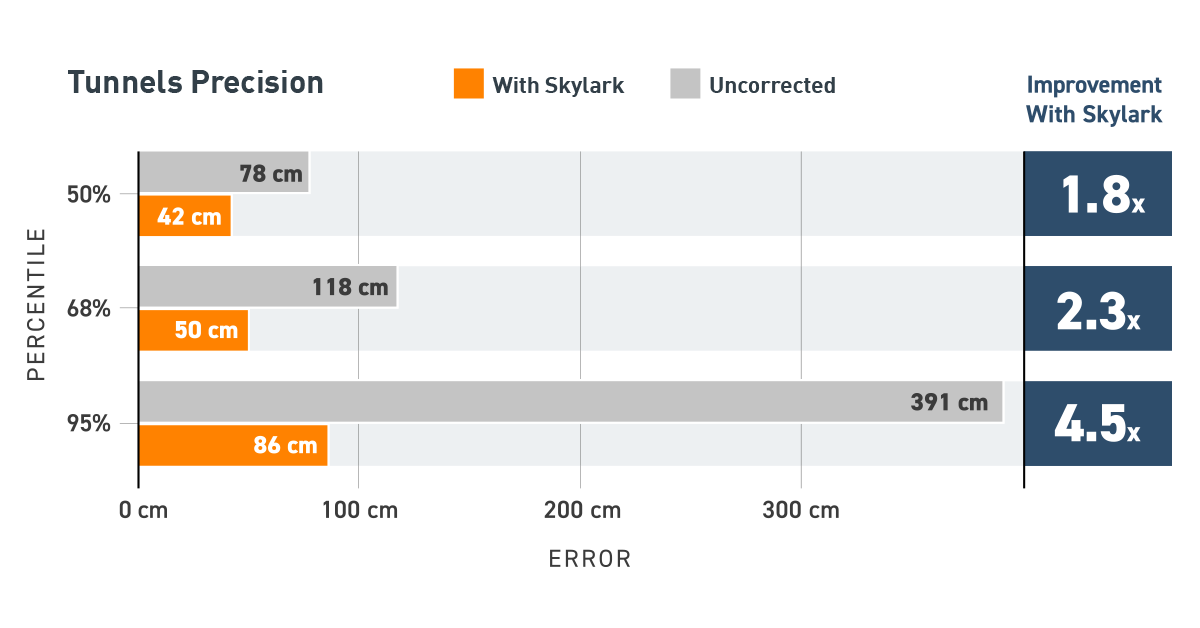
Blog
Swift Precise Positioning Enables Lane-Level Navigation Across Entire European Drive Test

Swift partnered with Deutsche Telekom (DT) to test its precise positioning solution on a 2,000 km drive test across Europe. We compared the accuracy of the positioning derived from an uncorrected GNSS system to the Swift corrected positioning leveraging Skylark. Read on to learn more about the results and implications of the drive test.
The automotive industry has made great strides in advanced driver assistance systems (ADAS), with features such as lane keeping assist and automated emergency braking enhancing the safety of vehicles on the road today. Early ADAS features relied heavily on perception-based sensors and relative positioning to identify safety threats, and absolute positioning enabled by GNSS has now been incorporated into intelligent transport systems (ITS) to improve the effectiveness of these features and enable new use cases.
In just a few short years we can expect to see much more advanced features in our vehicles, such as immersive navigation, crowdsourced maps, V2X coordination, and even fully autonomous driving. While perception-based sensors and relative positioning will always have a place in vehicles, next-generation ITS and cooperative intelligent transport systems (C-ITS) require precise absolute positioning to ensure redundancy, safety, and high availability in challenging driving conditions.
Safe Autonomous Driving Requires Sub-Meter Accuracy
Accuracy requirements for autonomous vehicles vary across industries and use cases. Consider an autonomous tractor harvesting berries in a field–an error of just a few centimeters could destroy crops and cost the grower millions of dollars in lost yield.
Cars and trucks don’t require quite the same level of accuracy. The typical highway lane is 3.5 meters wide and the typical car is 2 meters wide, so accuracy of 1 meter or less is sufficient to ensure the vehicle is within the proper lane. But unlike autonomous tractors, cars and trucks travel across long distances and encounter an array of challenging and unpredictable environments. Consumer and commercial vehicles require high availability and reliable performance across a range of conditions.
Testing Swift Precise Positioning Across Europe
Swift offers a suite of precise positioning products for automotive, including Skylark, a cloud-based GNSS corrections service, and Starling, a positioning engine with dead reckoning and sensor fusion.
Swift partnered with Deutsche Telekom (DT) to test the precise positioning solution on a 2,000 km drive test across Europe, from Hanover, Germany to Barcelona, Spain. DT deploys and operates the network of Continuously Operating Reference Stations (CORS) that Skylark leverages for its corrections across Europe. Swift partners with MNOs like DT around the world to ensure seamless, high-availability service delivered via carrier-grade infrastructure.
The drive traversed a wide variety of driving conditions including dense urban areas, tree-lined highways, the Alps, and its network of tunnels. The testing platform derived the Skylark corrected and the uncorrected tracks from the same GNSS receiver, both benefiting from dead reckoning aiding.
Skylark Improves Accuracy Compared to Uncorrected GNSS
The testing platform derived the Skylark corrected and the uncorrected tracks from the same GNSS receiver, both benefiting from dead reckoning aiding. Over the course of the entire drive, Skylark’s accuracy was 34 cm (95%), compared to 82 cm (95%) achieved by uncorrected GNSS. With accuracy requirements for automotive at 1 meter, it may seem like standard GNSS is good enough–so why bother with corrections? There are two important reasons to strive for greater accuracy:
- Accuracy at 95% means 5% of the time the positioning is less precise. As we move toward fully autonomous vehicles, we must increase the confidence in the accuracy of the position to ensure safe operations, and 82cm accuracy at 95% doesn’t leave much wiggle room.
- The overall accuracy doesn’t tell us how the system performed in the most challenging environments. Assisted and autonomous driving has to be safe everywhere, not just in unobstructed open sky conditions.
Testing Skylark in Challenging Conditions
Let’s zoom in on two environments that really put Skylark to the test: urban canyons (where signals are blocked by buildings and multipath errors are a challenge) and tunnel exits (where internal sensors in dead reckoning mode are relied on until the satellite signal is restored).
Skylark Shines in Urban Canyons
In Urban canyons, uncorrected GNSS delivered an accuracy of 1.01 m (95%), putting it just shy of the required accuracy for advanced automotive use cases. In comparison, Skylark delivered an accuracy of 27 cm (95%), easily meeting automotive requirements.

Urban areas are one of the most safety-critical environments for assisted driving and autonomous vehicles. Dense traffic, narrow lanes, cyclists, and pedestrians make cities difficult to navigate safely, even without the added challenge of blocked GNSS signals and multipath errors. These drive test results highlight how important GNSS corrections are in enabling the safe operation of vehicles in these densely populated areas.
Skylark Helps Vehicles Navigate Safely Through Tunnels
The results for tunnel exits were even more striking. Uncorrected GNSS only achieved an accuracy of 3.91 m (95%), making it an entirely unreliable solution. Skylark’s accuracy was 86 cm (95%), thanks to its fast re-convergence time.

Precise Positioning Enables the Future of Autonomy
As the automotive industry heads in the direction of more advanced ADAS features and fully autonomous vehicles, it’s clear that precise absolute positioning will be a requirement to ensure safe and reliable operations. Uncorrected GNSS does not provide the required accuracy to guarantee lave-level navigation in the diversity of real-world scenarios vehicles encounter.
Swift’s precise positioning solution meets the stringent automotive requirements for accuracy, availability, and safety, and is being deployed in over 5 million vehicles and devices worldwide. And while drive tests offer promising data, there is no substitute for extensive customized system testing with the specific combination of components in each vehicle. That’s why Swift experts, with over 60 collective years of experience at OEMs and tier-1 suppliers, partner closely with customers throughout the entire design lifecycle, from requirements analysis and system design through pilot programs and lifetime support.
Contact Swift to speak with an expert about your requirements.
